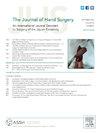Distal Radius Fracture in the Setting of Human Immunodeficiency Virus: Management and Adverse Events
IF 2.1
2区 医学
Q2 ORTHOPEDICS
引用次数: 0
Abstract
Purpose
Previous research has highlighted the elevated fracture risk among patients with human immunodeficiency virus (HIV). The current study assesses the association between HIV and the management and adverse events of distal radius fractures.
Methods
Patients with a distal radius fracture from 2016 to 2022 were identified in a national administrative database. Patients were stratified by HIV status, and antiretroviral therapy (ART) use was identified. Fracture treatment modality (open or closed) was determined, and adverse events were identified within 1 year of fracture. Treatment modality and adverse events were compared using logistic regression and chi-square tests, respectively.
Results
Among 396,544 patients with a distal radius fracture, 2,392 had HIV. HIV status was not associated with treatment modality. For patients with closed treatment, those with HIV had greater rates of malunion or nonunion and wrist arthritis. For patients with open treatment, HIV was also associated with greater incidence of malunion or nonunion. When stratifying by ART status, patients not on ART were less likely to undergo open treatment, whereas those with ART underwent open treatment at similar rates to HIV-negative patients. Compared with the HIV-negative cohort, those with HIV, and on ART were significantly more likely to sustain malunion or nonunion following closed treatment.
Conclusions
Patients with HIV are at increased risk for fracture, and they are more likely to experience adverse events following both closed and open management of distal radius fractures. Surgeons should pay close attention to bone healing in patients with HIV, and future research should investigate the causes of these adverse events and assess their modifiable risk factors.
Type of study/level of evidence
Prognostic II.
人类免疫缺陷病毒感染下桡骨远端骨折:处理和不良事件。
目的:先前的研究强调了人类免疫缺陷病毒(HIV)患者骨折风险增高。目前的研究评估了艾滋病毒与桡骨远端骨折的管理和不良事件之间的关系。方法:2016年至2022年桡骨远端骨折患者在国家行政数据库中进行鉴定。患者按艾滋病毒状况分层,并确定抗逆转录病毒治疗(ART)的使用情况。确定骨折治疗方式(开放或封闭),并确定骨折1年内的不良事件。治疗方式和不良事件分别采用logistic回归和卡方检验进行比较。结果:在396,544例桡骨远端骨折患者中,有2,392例感染了HIV。HIV感染状况与治疗方式无关。对于接受封闭治疗的患者,那些携带HIV病毒的患者有更高的不愈合或不愈合和手腕关节炎的发生率。对于接受开放治疗的患者,HIV也与更大的不愈合或不愈合发生率相关。当按抗逆转录病毒治疗状态分层时,未接受抗逆转录病毒治疗的患者接受开放治疗的可能性较小,而接受抗逆转录病毒治疗的患者接受开放治疗的比例与艾滋病毒阴性患者相似。与艾滋病毒阴性组相比,那些感染艾滋病毒并接受抗逆转录病毒治疗的患者更有可能在封闭治疗后维持不愈合或不愈合。结论:感染HIV的患者骨折风险增加,桡骨远端骨折无论是闭合治疗还是开放治疗,都更容易发生不良事件。外科医生应密切关注HIV患者的骨愈合情况,未来的研究应调查这些不良事件的原因,并评估其可改变的危险因素。研究类型/证据水平:预后II。
本文章由计算机程序翻译,如有差异,请以英文原文为准。
求助全文
约1分钟内获得全文
求助全文
来源期刊
CiteScore
3.20
自引率
10.50%
发文量
402
审稿时长
12 weeks
期刊介绍:
The Journal of Hand Surgery publishes original, peer-reviewed articles related to the pathophysiology, diagnosis, and treatment of diseases and conditions of the upper extremity; these include both clinical and basic science studies, along with case reports. Special features include Review Articles (including Current Concepts and The Hand Surgery Landscape), Reviews of Books and Media, and Letters to the Editor.

 求助内容:
求助内容: 应助结果提醒方式:
应助结果提醒方式:


